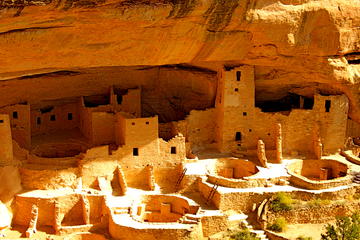
Mesa Verde National Park is a UNESCO World Heritage Site due to its rich history and cultural significance. This national park, established in 1906, helps us understand the lives of the Ancestral Puebloans, a Native American civilization that thrived in the area for centuries. So, learn more about the ancient cultures of Mesa Verde before you visit.
The Ancestral Puebloans
Initially, the Ancestral Puebloans dwelled in the Four Corners region, where Arizona, New Mexico, Utah, and Colorado converge. Their migration led them to Mesa Verde and the surrounding areas, shaping their identity and culture. Furthermore, their environment influenced daily life for the Ancestral Puebloans. Agriculture was fundamental, and they ingeniously cultivated crops like maize, beans, and squash despite the arid Southwest climate. Also, the farming practices of the ancient cultures of Mesa Verde allowed them to create stable communities within the challenging terrain.
Within these communities, the Ancestral Puebloans had a structured social hierarchy. Leaders emerged, overseeing the allocation of resources and making decisions for the group’s survival. Religion played a significant role in their lives, with ceremonial structures and kivas (underground chambers) serving as spaces for spiritual rituals and gatherings. These practices deepened their connection to the land and the spiritual forces they believed inhabited it.
Their mysterious disappearance
Once thriving in Mesa Verde, the Ancestral Puebloans left behind a great mystery as they abruptly left their cliff dwellings. This enigmatic disappearance has fueled countless theories and speculations. Some suggest environmental factors like prolonged droughts or resource depletion forced their departure. Others propose social or religious upheaval as potential causes.
While the Ancestral Puebloans vanished, their legacy remains palpable in the Southwest. Plus, their disappearance has also inspired preservation efforts and the safeguarding of cultural heritage. Archaeologists, historians, and indigenous communities collaborate to protect and study the remnants of this ancient civilization.

Kivas and ceremonial sites
Central to Ancestral Puebloan society, Kivas were subterranean structures vital for their religious and social life. These circular, underground rooms, typically entered through a small hole in the roof, held immense significance. Kivas served as places of communal gathering, where the Ancestral Puebloans conducted rituals, ceremonies, and important discussions. In addition, these structures vary in size and complexity, reflecting the evolving cultural practices and architectural expertise of the Ancestral Puebloans.
Some kivas are simple and small, while others are grand and elaborately decorated, displaying the diversity of their spiritual traditions. Within these kivas, the Ancestral Puebloans conducted various religious and ceremonial practices that held their community together. These gatherings reinforced their spiritual connection to the land, demonstrating a deep respect for the natural world. The kivas were places of introspection and celebration, where traditions were passed down through generations.
Cliff dwellings in Mesa Verde
These remarkable structures consist of tightly clustered stone rooms tucked into natural rock alcoves, providing shelter and protection for the people who once called them home. Historically, these cliff dwellings served as thriving communities. Families cooked, slept, and socialized in these rooms, creating a vibrant culture. Surprisingly, the construction materials used were simple yet ingenious—wooden beams and sandstone bricks. The Ancestral Puebloans used mud mortar to hold them together and, in some cases, even built multi-story complexes.
The significance of these architectural marvels lies in their adaptability to the challenging environment. Perched high above the canyon floors, they offered safety from the elements and potential threats. They reflect the resourcefulness of the Ancestral Puebloans, who managed to flourish in the harsh conditions of the Mesa Verde region. These dwellings also provide insights into their daily lives, rituals, and community interactions.

Modern-day exploration and preservation
Mesa Verde continues to be a center of exploration and preservation efforts today. While exploration is essential, so is the conservation and protection of its fragile treasures. Balancing tourism and preservation remains a priority. Guided by this aim, initiatives have been implemented to limit the impact of visitors on fragile archaeological sites. Sustainable practices, such as designated trails and visitor centers, have been established to limit the damage to the ecosystem.
Visitor engagement is a big part of the preservation efforts. Educational programs and guided tours allow visitors to learn about the history and significance of the site while fostering a sense of responsibility toward its protection. By connecting visitors to the past, this place inspires a deeper appreciation for the historical heritage of the Southwest.
Experiencing Mesa Verde today
Experiencing Mesa Verde today offers an unforgettable journey into the heart of this ancient wonder. Planning a visit to the national park is an adventure, with plenty of visitor information and accommodation options available. From campgrounds to lodges, there’s a place to suit every traveler’s style, ensuring a comfortable stay while surrounded by the rugged beauty of the Southwest. Plus, there are many must-see attractions and hiking trails you should explore. Cliff Palace, Balcony House, and Spruce Tree House are just some iconic cliff dwellings that take you back in time.
The park’s well-maintained hiking trails lead you through breathtaking vistas and offer a closer look at the breathtaking landscape. For those seeking an immersive experience, this place provides ranger-guided tours and cultural demonstrations. Expert guides share stories of the Ancestral Puebloans, their daily lives, and the mysteries that still linger. You can also participate in hands-on activities suitable for visitors of all ages, from pottery workshops to interactive exhibits that allow you to step into the shoes of the ancient inhabitants.

Travel and explore the ancient cultures of Mesa Verde
Mesa Verde, with its landscapes and ancient cultures, invites adventurers to uncover its secrets. Today, we discovered the Ancestral Puebloans’ rich history and architectural marvels. Various experiences and educational programs bring the ancient cultures of Mesa Verde to life, ensuring that this ancient wonder continues to inspire and educate.
Browse Mesa Verde Tours Now Available
About the author:
 Emma Smith is an explorer and a writer whose passion for travel is matched only by her talent for crafting captivating narratives. Emma writes articles that transport readers to historic destinations. In addition to her writing, Emma has collaborated with Royal Moving and Storage California to share practical tips and insights for seamless relocations, helping readers turn their travel dreams into reality.
Emma Smith is an explorer and a writer whose passion for travel is matched only by her talent for crafting captivating narratives. Emma writes articles that transport readers to historic destinations. In addition to her writing, Emma has collaborated with Royal Moving and Storage California to share practical tips and insights for seamless relocations, helping readers turn their travel dreams into reality.
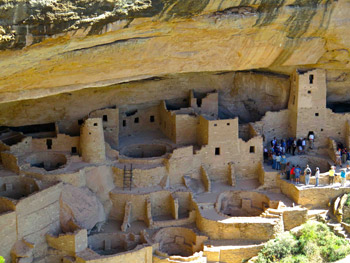
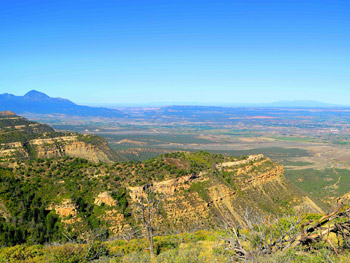 Evidence of settlement on the Colorado Plateau only dates back to AD 550, but signs of human presence on the plateau go back at least 10,000 years to the Paleolithic Age. For much of the known history of these people, they existed as tribes of wandering hunter gathers. Forging for food is easier than farming.
Evidence of settlement on the Colorado Plateau only dates back to AD 550, but signs of human presence on the plateau go back at least 10,000 years to the Paleolithic Age. For much of the known history of these people, they existed as tribes of wandering hunter gathers. Forging for food is easier than farming.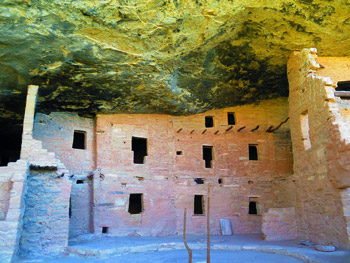 The Anasazi are rich in history. What is emerging is from the archeology work is a complex and, somewhat egalitarian, society. They succeeded to thrive for millennium in a sparse land with harsh winters. The archeological evidence of the Anasazi date back to 1200 BC—a time known as the “Basket Making Era” since they had baskets, but no pottery, and lived in camps or caves, surviving off a staple of cultivated squash and corn.
The Anasazi are rich in history. What is emerging is from the archeology work is a complex and, somewhat egalitarian, society. They succeeded to thrive for millennium in a sparse land with harsh winters. The archeological evidence of the Anasazi date back to 1200 BC—a time known as the “Basket Making Era” since they had baskets, but no pottery, and lived in camps or caves, surviving off a staple of cultivated squash and corn.
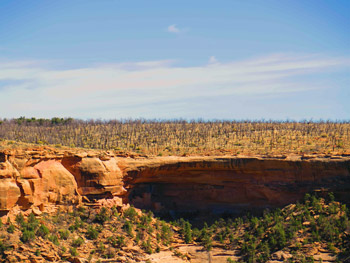 If you’re coming from Denver, you’ll enjoy the scenic, mountain-carved route along US Highway 160W and US 285S. I drove in from Grand Junction, along US 50. If you can do this drive in the fall, roll your windows down and you can smell the yellow and red leaves bursting in bright patches amongst ever-steady green pines. Carved cliffs of rock will add earthy tones to the pallet, and blue sky might cause you to turn the radio down so as to let the evolving panoramic fill your senses.
If you’re coming from Denver, you’ll enjoy the scenic, mountain-carved route along US Highway 160W and US 285S. I drove in from Grand Junction, along US 50. If you can do this drive in the fall, roll your windows down and you can smell the yellow and red leaves bursting in bright patches amongst ever-steady green pines. Carved cliffs of rock will add earthy tones to the pallet, and blue sky might cause you to turn the radio down so as to let the evolving panoramic fill your senses.
